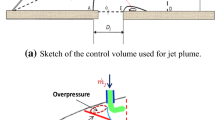Abstract
This paper proposes advanced approach able to calculate the gas properties with the temperature of binary gas mixture using the diffusion-based diameter and investigates the performance of thermal flying control for different temperature and fraction ratio at head disk interface. It is found that because of the combined effects of mean free path, thermal conductivity and viscosity, the heat transfer coefficient increases with the increase of fraction of ratio, while it decreases with the increase of temperature reversely. In addition, the pole-tip protrusion increases substantially with increase of the fraction ratio. And in higher temperature, it linearly decreases more.









Similar content being viewed by others
References
Bird GA (1994) Molecular gas dynamics and the direct simulation of gas flows. Oxford University Press, New York
Cengel YA, Boles MA (1994) Thermodynamics, 2nd edn. McGraw-Hill, New York
Chen D, Bogy DB (2010) Simulation of static flying attitudes with different heat transfer models for a flying-height control slider with thermal protrusion. Tribol Lett 40:31
Holsen JN, Strunk MR (1964) Binary diffusion coefficients in nonpolar gases. I EC Fundam 3:143
Liu N, Zheng J, Bogy DB (2009) Thermal flying-height control sliders in hard disk drives filled with air–helium gas mixtures. J Appl Phys 95:213505
Liu N, Zhend J, Bogy DB (2011) Thermal flying-height control sliders in air–helium gas mixtures. IEEE Trans Magn 47:100
Park K-S, Park Y-P, Park N-C (2011a) Prospect of recording technologies for higher storage performance. IEEE Trans Magn 4:539
Park K-S, KIM K-H, Park Y-P, Park N-C (2011b) Investigation of dynamic characteristics of light delivery for thermal assisted magnetic recording. IEEE Trans Magn 47:1992
Park K-S, Lim G, Park Y-P, Hong E-J, Park N-C (2012) Analysis of the unloading performance considering dimple—flexure behavior in HDD. Microsyst Technol 18:1389–1399
Poling BE, Prausnitz JM, O’Connell J (2001) The properties of gases and liquids, 5th edn. McGraw-Hill, New York
Zhang S, Bogy DB (1999) A heat transfer model for thermal fluctuations in an thin slider/disk air bearing. Int J Heat Mass Transf 42:1791
Zhou WD, Liu B, Yu SK, Hua W (2009a) Inert gas filled head–disk interface for future extremely high density magnetic recording. Tribol Lett 33:179
Zhou WD, Liu B, Yu SK, Hua W (2009b) Effects of temperature dependent air properties on the performances of a thermal actuated slider. Tribune Int 42:902
Zhou WD, Liu B, Yu SK, Hua W, Wong CH (2009c) A generalized heat transfer model for thin film bearings at head–disk interface. Appl Phys Lett 105:084303
Author information
Authors and Affiliations
Corresponding author
Rights and permissions
About this article
Cite this article
Park, KS., Choi, J., Park, NC. et al. Effect of temperature and helium ratio for performance of thermal flying control in air–helium gas mixture. Microsyst Technol 19, 1679–1684 (2013). https://doi.org/10.1007/s00542-013-1878-9
Received:
Accepted:
Published:
Issue Date:
DOI: https://doi.org/10.1007/s00542-013-1878-9




